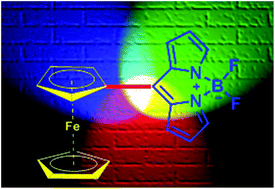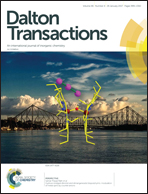Second-order nonlinear polarizability of ferrocene–BODIPY donor–acceptor adducts. Quantifying charge redistribution in the excited state†
Abstract
A series of dyads and triads using ferrocene (Fc) as the donor and 4,4-difluoro-4-bora-3a,4a-diaza-s-indacene (BODIPY) as the acceptor, linked either directly or through an N-phenylmethanimine or ethynylbenzene linker have been synthesized. While the former (directly linked) dyads were prepared through acid catalyzed condensation of pyrrole with ferrocenecarboxaldehye or 1,1′-ferrocenedicarboxaldehyde followed by oxidation with 2,3-dichloro-5,6-dicyano-1,4-benzoquinone (DDQ), the latter two sets (imine and alkyne linked) of dyads were obtained through Schiff base condensation or Sonogashira coupling reactions, respectively. The compounds were fully characterized with spectroscopic data and single crystal X-ray analysis in one case. The peaks corresponding to the Fe(II)/Fe(III) redox couple at 0.33 to 0.38 V showed a varying degree of positive anodic shift, which reflected the strong electron withdrawing effect of the corresponding BODIPY unit. The first hyperpolarisability, β, was measured in chloroform using the femtosecond hyper-Rayleigh scattering (HRS) method at 1300 nm. Interestingly, from the βHRS values, the dominating role of the Fc donor and the intervening linker could be established, which correlated well with the experimental linear optical data as well as theoretical data calculated using density functional theory (DFT) and time-dependent DFT calculations. This work constitutes the first report where electron accepting power of BODIPY in combination with the Fc donor moiety, is exploited and we demonstrate that the values are comparable to that of push–pull derivatives where BODIPY was used as the conjugated linker.



 Please wait while we load your content...
Please wait while we load your content...